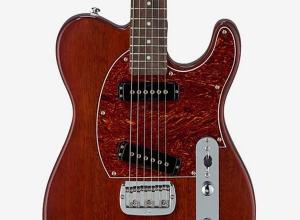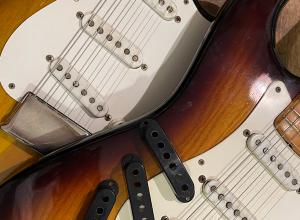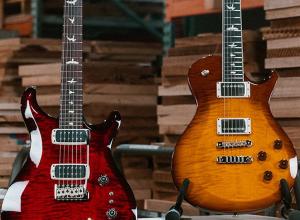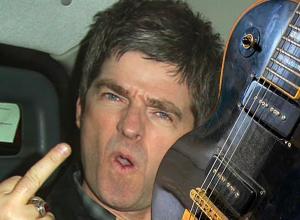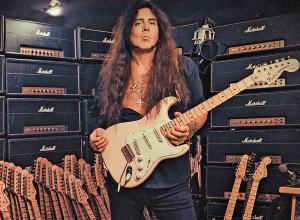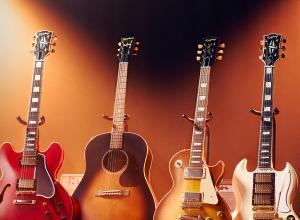Fu amore a prima vista, che portò William a mettere assieme una magnifica collezione di Schecter costruite a Van Nuys da David Schecter e a essere animatore di gruppi social dedicati alla sua produzione. Lo abbiamo intervistato.
Domanda: Che chitarrista sei? Raccontaci di te.
Risposta: Grazie innanzitutto per questa gentile opportunità di riflettere sulle mie chitarre preferite, le Schecter dell'era Van Nuys! Che tipo di chitarrista sono? Questa è un'altra domanda difficile! Direi che abbraccio tutti gli stili. Da autodidatta ho suonato tutto quello che le mie orecchie sentivano sui dischi e alla radio, sono cresciuto con la Motown. Ho cominciato a suonare il pianoforte molto presto, poi volevo diventare un batterista, ma a quattro anni ho sentito Red House... Ho chiesto a mio padre che cosa producesse quel suono e lui mi ha risposto che era una chitarra elettrica, ma che quello era Jimi Hendrix e che nessun altro lo faceva in quel modo. Quindi, per rispondere alla domanda sul chitarrista, sono un suonatore di jamband rock funk soul, pesantemente influenzato da decine di chitarristi, Garcia, Gilmour, Knopfler, Jimi, Beck, Gatton, EVH, Page, Haynes sono i miei grandi amori. Ho suonato con due gruppi qui a Detroit per anni, un power trio con Mike Daniell (batteria) e Aaron Rivera (basso) chiamato Fezziwig dal 1999. E una jam band psichedelica chiamata Ashray che ha coinvolto me per circa dieci anni, Jeff Archer (chitarra), Nick Krause (batteria) e Aaron Rivera (basso)...
A: Quando e perché è cominciata la tua passione per le chitarre Schecter?
R: Quando avevo 11 anni, gli Who suonavano Schecter teles su MTV... Anche i Dire Straits avevano delle strat colorate e malvagie. Knopfler, Lindes, Sonni le avevano tutte e, a testimonianza di ciò, tutte possiedono e suonano ancora queste chitarre. I suoni, i legni e gli specchi in ottone o l'elegante hardware nero mi hanno conquistato fin da piccolo. Grazie a queste chitarre, sono stato ispirato a realizzare il mio hardware e persino i plettri in titanio e altri metalli, un altro incredibile risultato della loro ispirazione. Ho una pagina Instagram () con foto divertenti di questo lavoro, delle Schecter e della pesca, un'altra mia passione!
D: Al di là dei tuoi gusti musicali, quali sono i modelli Schecter che ritieni più interessanti e soprattutto validi anche oggi?
R: Un'altra domanda fantastica e difficile! Certamente il modello PT e il concetto di super-Strat a doppio humbucker hanno catturato l'immaginazione di una miriade di suonatori e, in molte forme, continuano a rappresentare una forza nelle loro mani. Con questo intendo le Telecaster a doppio humbucker con pickup splittabili preferite da Pete Townshend, ovviamente, e anche il fatto che Schecter sia in linea (concettualmente o dal punto di vista commerciale) con altri progenitori dell'hotroding, primo tra tutti Charvel. L'azienda attuale continua tuttora a produrre queste chitarre in molte varianti. Anche i pickup single coil con tapping e i tremoli in ottone o gli hardtail sui modelli Strat con legni esotici sono stati molto importanti per me, anche come musicista. Detto questo, le Strat a doppio humbucker sono le mie preferite... i vecchi humbucker Superock sono in grado di coprire molti suoni vintage e moderni, con un attento controllo del volume della chitarra si possono ottenere botte potenti o sfumature delicati... è tutto qui.... le diverse combinazioni danno al musicista una tavolozza di colori come nessun altro strumento...
D: Quali sono secondo te le principali qualità delle chitarre Schecter dell'epoca d'oro, anche rispetto alla produzione contemporanea che sembra aver riscoperto - almeno nel marketing - le radici di Van Nuys?
R: La produzione CNC ha portato coerenza nel mondo delle chitarre. Oggi solo alcuni costruttori boutique si attengono ai vecchi metodi, realizzati interamente a mano, come il mio caro amico Ivan Leschner, con strumenti di base e/o con una minima assistenza meccanica. Schecter aveva molti strumenti progettati e costruiti da Dave Schecter e perfezionati con Tom Anderson, che poi li ha messi in produzione... Il ruolo di Tom non può essere sottovalutato, poiché è stato anche il catalizzatore dei pickup... Con questi strumenti e in quel paradiso della liuteria furono in grado di replicare i profili di manico e corpo. Un gruppo di talento ad alta potenza, una piccola officina meccanica hotrod. Le cose venivano rifinite in piccole serie da persone di talento, quindi la qualità non ha eguali in nessun'altra epoca di qualsiasi marca e il musicista la percepisce. Mio padre era un venditore e da bambino mi ha insegnato ad avere un occhio di riguardo per la qualità. Accettava di vendere un prodotto solo se era veramente convinto che fosse di altissimo livello. Questa lezione è certamente il motivo per cui ho sempre apprezzato la produzione Schecter. Il team di cui si avvaleva era composto da persone provenienti da tutto il mondo, tutti luminari e menti attente, votate all'eccellenza nella ricerca della chitarra. Legni e hardware come nessuno aveva mai visto e poi il tono e la suonabilità, che trascendono tutte le altre chitarre che ho suonato nel corso degli anni.
D: C'è davvero così tanta differenza, come sostengono alcuni, tra le Schecter costruite a Van Nuys e quelle costruite a Dallas e quelle di oggi?
R: C'è una grande differenza. La squadra di Van Nuys era un vero e proprio cast di stelle, una concentrazione di talenti. La maggior parte dei protagonisti del custom shop di Schecter sono poi diventati proprietari di boutique di altissimo livello. Dave Schecter, che ho contattato due anni fa e che mi ha realizzato un paio di meravigliosi set di pickup, mi ha sempre incoraggiato a migliorare, in ogni ambito. Condividiamo ancora l'amore per Telecaster, la Motown, le auto, il CNC. Tom Anderson, Pat Wilkins, Tom Keckler, "Obe" Obelinger, solo per citarne alcuni, sono stati tutti estremamente gentili e disponibili nei miei confronti, per aiutare il mio percorso con questi strumenti. Inoltre, il venditore del negozio, David Paranzino, è un amico meraviglioso. Era entrato alla ricerca di una decalcomania per una costruzione e ha finito per lavorare lì per diversi anni! È doveroso menzionarlo perché è sempre stato paziente e mi ha aiutato a capire a fondo la storiadel brand, oltre a essere un eccellente musicista professionista di successo. Molti dipendenti di Van Nuys erano ottimi musicisti. Le chitarre di Dallas sono di qualità piuttosto elevata, ma sono state realizzate principalmente con corpi e manici importati da Lasido in Canada e da ESP, che non avevano alcuna somiglianza e feel con i prodotti precedenti. Solo nei primi esemplari si sono utilizzate alcune parti rimaste in magazzino, per cui è possibile vedere hardware ed elettronica e persino, occasionalmente, un manico o un corpo Van Nuys su una Dallas.
D: Circolano molte voci sul trasloco da Van Nuys a Dallas, qualcuno parla addirittura di merce sottratta di notte. Tu sai qualcosa di questa vicenda.
R: Solo le stesse voci. Purtroppo le persone che hanno portato l'azienda a Dallas non avevano una competenza chitarristica, vendevano congelatori per la carne. Da quello che sembra, erano solo uomini d'affari con una mentalità da consiglio di amministrazione. Da qui il breve periodo prima della la vendita a ESP...
D: Per quanto apprezzate e ricercate, le chitarre Schecter dell'epoca d'oro si scambiano comunque a prezzi che sono una frazione rispetto a quelli di Fender e Gibson. Secondo te perché?
R: La consapevolezza e la prevalenza dei marchi sopra citati. E poi le prime Schecter sono in ritardo di 20 anni sulla curva del tempo di invecchiamento, anche se costruite con legni antichi ed esotici. Le chitarre prodotte oggi non saranno mai altrettanto buone o uguali, perché quel legno è scomparso. Schecter faceva arrabbiare persino i costruttori di mobili californiani che si recavano dai fornitori di legno e si lamentavano. Chi erano questi ragazzi che si impadronivano dei pezzi migliori? Va detto che la seconda epoca d'oro, quella che mi piace considerare come l'epoca delle hotrod mod della California degli anni '70-'80, ha quasi 50 anni, mentre le migliori Fender e Gibson hanno quasi 70 anni... E poi di Schecter non ce ne sono molte, poche migliaia di chitarre in totale, includendo anche quelle costruite dai rivenditori nel loro glorioso periodo 1978-1984, la gente non le ha mai avute tra le mani. La domanda e l'offerta funzionano in modo strano. Sono solo contento che siano di così alta qualità e che verranno suonate per decenni. Quindi, ancora una volta, si tratta di oggetti poco noti apprezzati soprattutto dagli addetti ai lavori. Per esempio, potete vedere il mio buon amico Terence Reis in tour con i Dire Straits Experience dall'altra parte dell'oceano con alcune incredibili Schecter nelle sue magistrali mani. Seguite il tour per vedere e sentire come vengono maneggiate queste chitarre!
D: Raccontaci le tue chitarre Schecter: la prima che hai avuto, la tua preferita, quelle che hai ma non suoni, quella che non hai ma vorresti avere (se esiste).
R: Prima di tutto, mentre costruivo una Partscaster, come si suol dire, il mio percorso fortunato è iniziato con un manico di una Strat con logo Schecter burn e firmato da "Obe"... L'ho preso su eBay per pochi soldi, dato che l'inserzione non era del tutto corretta. Quando è arrivato e l'ho preso in mano la sensazione è stata incredibile. Ho fatto delle ricerche su cosa fosse, ho capito che i miei eroi suonavano gli stessi manici trattati da questo team e mi sono appassionato. Da lì, ho iniziato a cercare instancabilmente pezzi da assemblare e questo mi ha portato ad avere molte chitarre intere. Ho conosciuto molte persone e mi sono fatto molti, molti buoni amici. Ogni chitarra che ho ora la considero un regalo di un amico e posso raccontare la storia di ognuna di esse. Spero di trovare il tempo di scrivere un libro su queste cose, quando la vita me lo permetterà, e sicuramente parlarne qui mi sprona a farlo.
In ogni caso, avere in mano quel manico è stata la sensazione più bella che abbia mai provato. Ancora oggi, dopo averne avuti molti tra le mani grazie alla fortuna e all'appassionata perseveranza, sono tutti diversi, ma offrono tutti sensazioni meravigliose e uniche. Per rispondere sulla mia preferita, si tratta di una Strat con corpo in pezzo unico in imbuya (noce brasiliano), con binding e doppio humbucker e manico in acero fiammato. Ho anche una Tele-Strat con corpo in palissandro brasiliano e pickup F500T, seconda a pari merito con alcune altre, ed è stata anche la mia prima Schecter. Detto questo, ognuna di esse è una Schecter, quindi le buone vibrazioni sono coerenti, ma sono come pennelli o spezie a seconda di ciò che si sta dipingendo o cucinando, e le amo davvero tutte. E la mia meravigliosa moglie è molto comprensiva e paziente...
![Fatto a Van Nuys: William Isbey e la sua collezione di chitarre Schecter [IT-EN] Fatto a Van Nuys: William Isbey e la sua collezione di chitarre Schecter [IT-EN]](https://www.accordo.it/cloud-assets/00/redazionea5a/images/095249IMG_4951.JPG)
[EN] Made in Van Nuys: William Isbey’s Schecter guitars collection
William Isbey’s passion for Schecter guitars has lasted for well over a quarter of a century, ever since he – as an 11-year-old – watched Dire Straits and The Who show off magnificent “Fender style” guitars on MTV in striking colors, with anodized metal pickguards and black pickups for contrast. It was love at first sight, which led William to put together a magnificent collection of Schecters built in Van Nuys by David Schecter and to be an animator of social groups dedicated to his production. We interviewed him for Vintage Vault.
Q: What kind of guitarist are you? Tell us about yourself.
A: Hello and many thanks, first of all, for this kind opportunity to reflect on my favorite guitars, Van Nuys-era Schecters! As to what kind of guitarist am I? That’s another tough question! I would say I embrace all styles and being nearly all self-taught it was a matter of playing along to what my ears heard on records and the radio growing up in Motown. I started playing piano very young and really wanted to be a drummer, but then at four years old I heard Jimi Hendrix… Red House… I asked my father what made that sound, and he said, an electric guitar, but that it was Jimi Hendrix and no one else did it quite that way. So to answer the guitarist question, I am a jamband rock funk soul player, heavily influenced by dozens but Garcia, Gilmour, Knopfler, Jimi, Beck, Gatton, EVH, Page, Haynes are big loves… I have played with two groups here in Detroit for years, a power trio with Mike Daniell (Drums) and Aaron Rivera (Bass) called Fezziwig since 1999. And a psychedelic jam band called Ashray which has involved me for about ten years, Jeff Archer (guitar), Nick Krause (drums) and Aaron Rivera (bass)…
Q: When and why did your passion for Schecter guitars begin?
A: When I was 11, The Who were playing Schecter teles on MTV… Dire Straits as well with wicked colorful strats. Knopfler, Lindes, Sonni all had them, and as a testament, they all still own and play these guitars… The sounds, the woods and brass mirrors or sleek black hardware… they had me at hello as a young kid… Through these guitars, I have been inspired to make my own hardware, and even guitar picks out of titanium and other metals, which has been another incredible upshot of their inspiration. I have an Instagram @isbeycustomdesigns page with fun pictures of this work, Schecters and fishing, another passion of mine!
Q: Beyond your musical tastes, which Schecter models do you think are the most interesting and, above all, still valid today?
A: Another awesome and tough question! Well certainly the PT model, and the concept of the double humbucker super-Strats have captured the imaginations of, and in many forms continue to be forces in the hands of a myriad of players. By that I mean the dual humbucker tele with tappable pickups favored by Pete Townshend of course, and as well Schecter being in (conceptually or business-wise) lock-step with other hotrod grandfather progressives like Charvel. The current company continues to produce these variants in many flavors to this day. The tappable single coil sized pickups, and brass tremolos or hardtails on the strat models with exotic woods became very important to me as a player as well. And all that said, dual humbucker strats are my favorite type… the old superock humbuckers can tap to cover many vintage to modern sounds… with careful control of guitar volume you can elicit extreme powerful hammers or delicate flowers… that’s the deal…. individual switching combinations gave the player a color palate like no other…
Q: What do you think are the main qualities of Schecter guitars from the golden era, even compared to contemporary production that seems to have rediscovered-at least in marketing-the roots of Van Nuys?
A: CNC production has definitely brought consistency to the world of guitars. There are boutique builders now who ascribe to the old ways, whether entirely made by hand, like my close friend Ivan Leschner, with basic tools, and/or with minimal machine assistance. Schecter had many tools which were designed and built by Dave Schecter and refined with Tom Anderson who implemented them for production purposes… Tom’s role cannot be understated, as he was the pickup catalyst as well… With these tools, in a hotrod luthier haven, they were able to replicate neck and body carves, and push designs with a high-powered talented group like a little hotrod machine shop. The quality, as things were finished in small runs by the talented people there, is like no other era of any make and feels to the player’s hands as such. My father was a salesman and taught me an eye for quality as a child. He would only represent a product if he truly believed it was of the highest maker’s concern. That lesson is certainly why I embraced Schecter builds. Also the team they had there was assembled from far and wide and without exception were luminaries and careful minds hell bent on excellence in the guitar pursuits. Besides lumber and hardware like no one had seen before or since, the tone and playability simply transcends many other guitars I have played over the years… 🙂
Q: Is there really as much difference, as some claim, between the Schecters built in Van Nuys and those built in Dallas?
A: There is a vast difference. The Van Nuys team was in fact a veritable all-star cast! The talent they had there was very concentrated and deep. Most of the key players in the custom shop have gone on to own their own shops of the highest regard. Dave Schecter, who I reached out two years ago and has made me a couple wonderful sets of pickups, always encouraged me to push myself in all regards. We still share the love of telecasters, Motown, cars, CNC. Tom Anderson, Pat Wilkins, Tom Keckler, “Obe” Obelinger, to name a few, all have been supremely kind and helpful to me as I understand my journey with these instruments as a player. Also, the shop salesman David Paranzino is a wonderful friend. He tried to get a decal for a build one day and ended up working there for several years! He must be mentioned as he has always been patient and helped me understand the history immensely, and is a monster professional player of success in his own right! Many Van Nuys employees were fine players! Dallas guitars are of quite high quality and were primarily made with import bodies and necks from Lasido in Canada and ESP, which did not bear any resemblance or feel to the earlier pieces. They did run out some stock parts wise in those builds so you’ll see hardware and electronics and even occasionally a Van Nuys neck or body on a Dallas build.
Q: There are a lot of rumors circulating about the move from Van Nuys to Dallas, some even talk about goods being stolen at night. Do you know anything about this?
A: Only the same rumors and speculation. Sadly, the people who took the company to Dallas were not guitar-minded in any respect. They sold freezers for meat. True story. From what it seems, they were just bottom-line business suits, with a boardroom mentality. Hence the short stint there and sale to ESP…
Q: As well-regarded and sought after as they are, Schecter guitars from the golden era still trade at prices that are a fraction of those of Fender and Gibson. Why do you think that is?
A: Awareness and the prevalence of the aforementioned brands. The early Schecter stuff is also 20 years behind the curve of old wood, but they still were sourcing old growth and exotic woods. The guitars made today will never be as good or the same. The wood is gone… Schecter was even angering California furniture builders who went to wood suppliers and complained. Who were these guys? Haha. The second golden era, what I like to think of as the California 70s-80s hotrod mod age, is nearly 50 years old now, whereas the Fenders and Gibsons are getting up to 70 years old. It is also far more scarce so people haven’t had them in their hands. They only made a few thousand guitars total, which includes dealer parts builds, in their glorious run from 1978-1984. Supply and demand works in strange ways. I am just glad they’re such high quality, and will be played for decades to come. So again, these are sleepers which those in the know cherish… For instance, you can catch my good friend Terence Reis on tour with the Dire Straits Experience across the pond there with some incredible Schecters in tow, under command of his masterful hands! Catch up with that tour to see the torch bearer to see and hear how these guitars are wielded!
Q: Tell us about your Schecter guitars: the first one you had, your favorite, the ones you have but don’t play, the one you don’t have but wish you had (if any).
A: Right on… First off, while building partscasters, as they say, my lucky path started with a single strat neck which was Schecter burn logo’d and signed by “Obe”… I got it on ebay for a little money, as the listing wasn’t quite right. When it arrived and I got a hold of it in my hand, the feeling was amazing…I did my research as to what it was, realized my heroes played the same necks also handled by this team, and I was hooked.
So from there, I began tirelessly seek out parts to cobble, and that led to many whole guitars… And taught me to reach out to people, and through this connection I have made many, many good friends. Every guitar I have now, I consider to be from a friend, and I can tell the story of every one. I hope to take time to write a book about these things as life permits, and certainly getting to talk about them here spurs that on!
Anyhow, it was the most wonderful feeling neck to my hand I had ever felt. To this day, with many through my hands due to good luck and passionate perseverance, they still vary and offer wonder and unique player feel every time. To answer about my favorite one, it is an imbuya (brazilian walnut) one piece body, bound dual-hum strat, with a highly flamed birdseye maple jumbo boatneck. I also have a Brazilian rosewood body telestrat with an f500t assembly which is tied for a close second with a few others, and it was also my first one. That said, each is analogous to being a Schecter, so the vibe is consistent, but they are like paintbrushes or spices depending on what you are painting or cooking,,, I really love them all dearly. My wonderful wife is most understanding and patient. |
 VINTAGE VAULT
VINTAGE VAULT
 SHG MUSIC SHOW
SHG MUSIC SHOW
 PEOPLE
PEOPLE
 STORE
STORE
 - Privacy - Accordo.it Srl - P.IVA 04265970964
- Privacy - Accordo.it Srl - P.IVA 04265970964
![Fatto a Van Nuys: William Isbey e la sua collezione di chitarre Schecter [IT-EN] Fatto a Van Nuys: William Isbey e la sua collezione di chitarre Schecter [IT-EN]](https://www.accordo.it/cloud-assets/730x450/redazionea5/images/deco/105092_schec-g.jpg)
![Fatto a Van Nuys: William Isbey e la sua collezione di chitarre Schecter [IT-EN] Fatto a Van Nuys: William Isbey e la sua collezione di chitarre Schecter [IT-EN]](https://www.accordo.it/cloud-assets/00/redazionea5a/images/095249IMG_4951.JPG)

























